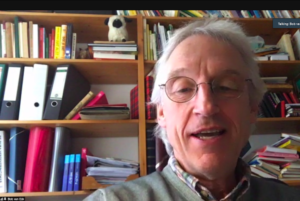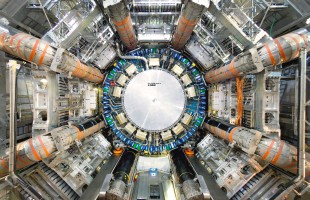
He had saved up vacation days for it and already had the plan all figured out. Bob van Eijk, an ATLAS researcher with a chair in Enschede, was to spend the last year before his retirement from Nikhef at CERN in Geneva. To try out some final ideas. To finalize a few things.
But then the corona pandemic swept over the world and nothing came of a stay in Geneva. Instead, he worked mainly from home, in Castricum. Later again once a week at Nikhef, in an office full of paper, equipment, electronics.
Now he supervises his last three PhD students in Enschede, where he was a professor for a long time. And after that, it’s largely done, he says after his last week of work. “You slide in and you slide out again. Not a big deal at all. That’s how it goes in science. And you mustn’t become an old man who thinks he knows everything better. Give young brilliant people space. Who am I to get in their way.”
Bob van Eijk (Brouwersgracht, Amsterdam 1955), as the son of a fur and leather merchant, was the first in his family to continue studying. Wandered (“Five years of celebration”) through the havo in Alkmaar, and went to the HTS, department of electrical engineering. “There I saw the light in the second year. I learned all kinds of things, but kept wondering how it really worked. Theoretical physics, that seemed great.”
At the University of Amsterdam, he became fascinated with the field of study of the young professor of theoretical physics Karel Gaemers (later Nikhef director). He assisted with working lectures and received an invitation to the CERN summer school in Geneva. To be honest, student Van Eijk had never heard of it, of that CERN. But he did go.
And the rest is history, he tells us. “It was the seventies, particle physics was prominent in the news and that made it very exciting. I was able to join the Delphi project for two months and immediately found it insane there.” He graduated quickly in late 1982. On research into the then still very theoretical Higgs particle.
Wasn’t that extraordinary, a theorist becoming an experimenter?
“You know, I’ve always had a very practical mind. If something doesn’t work, from the clogged sink at home to an experiment at CERN, I almost automatically pick up a screwdriver, because it can’t be that complicated. And it’s the same in theory. Give me something and I’ll try to fix it. I am a doer. And the funny thing is that I know how that appeals to some students who are less interested in theory.”
After graduating, Nikhef director Walter Hoogland asked him to visit for a long time in Amsterdam and offered him a PhD position. “What, I was more or less allowed to think up myself. Just go visit some people at CERN, he said. I was rather hesitant. A PhD job, me – wasn’t that very lofty?”
But once at CERN, all doubts vanish when he walks into the UA1 experiment of the later Nobel laureate Carlo Rubbia, which hunts for the W and Z particles of the weak nuclear force with the SppbarS machine, the first to shoot protons at antiprotons. The detector is just recovering from a disaster. A flood has submerged the experiment. Rubbia and his team are pulling out all the stops to get back on their feet.
Against so much raw scientific drive, the young Dutchman is no match. “Rubbia was a beast and could be very unkind, but you just had to stand up to that, then things would work out. We Dutch can do that, I think. When I got my PhD he wrote a wonderful recommendation for me.”
Around 1990, Van Eijk was back in the Netherlands and at Nikhef involved in one of the biggest projects ever: the design and construction of the new ATLAS detector at CERN. Destined for the LHC accelerator, to be built in the existing LEP tunnel. As a young PhD student, he once attended the meeting in Lausanne, where the idea of an LHC accelerator was first widely presented.
Love at first sight, the ATLAS detector?
“I remember fierce discussions about whether Nikhef should get into ATLAS or the competing CMS project. I was very much in favor of ATLAS, a very versatile detector. CMS was not only very understaffed in the beginning, but also quite limited in my opinion. That, by the way, later worked out well there as well.”
A giant project like ATLAS involves not only physics and engineering, but also a lot of diplomacy, says Van Eijk. “You have discussions about everything, but you always have to make sure you keep people together. ATLAS was an amalgamation of the EAGLE project of Nikhef and others and the ASCOT project of Max Planck in Munich. Then you have to make compromises. Otherwise talented people will walk away. Sometimes that means you have to settle.”
Not always proven right, then?
“Certainly not. For example, I was not in favor of us doing the manufacturing of certain parts of the detector. Then you build the same thing thousands of times and test, but it’s too much of a factory and not enough research. But it did happen and that’s how these things go sometimes.”
It did result in the discovery at ATLAS of the higgs, in 2012.
“That was fantastic, of course. Although I actually remember the first collisions before that in our detector even better. The feeling that it worked, after all that effort, that was overwhelming. Then it was worth it that you were never at home, and always working. Despite your young family.”
So what keeps you going?
“I once chose academic freedom. That suits my character, but it means even more. I’m not brilliant at my craft, I don’t win Nobel prizes, I’m a doer. But I have the honor of working with young people, a few of whom will be brilliant and win prizes. They deserve your full commitment.”
Do you get enough room for that in today’s education system?
“That’s tricky. People are completely stuck in educational tracking systems and work schedules. And in projects with thousands of participants. I like to tell PhD students: do something other than your own analyses for a while. Think about neutrinos for a month, for example. About the new FCC accelerator. Young people have to do it sometime. Older physicists may be thinking too much about continuity and existing structures like CERN.”
CERN is the heart of particle physics in Europe, though.
“CERN is very important, it is a magnet for talent, a beacon of collaboration and attracts all kinds of high-tech. Very important. But if particle physics unexpectedly stops moving forward, we should also dare to do something else.”
Such as?
“There are still plenty of questions in particle physics, don’t worry. We won’t find really new things for a while, but with precision measurements in the LHC we are now getting surprisingly far. And there are still plenty of big questions. Why do the particle masses differ so greatly? Or the neutrinos, we still know so little about them. We are far from finished.”
How did you actually end up at the University of Twente?
“Via the then Nikhef ATLAS coordinator, Cees Daum. The LHC accelerator required knowledge of superconducting materials for the magnets, and Twente had a very strong group in that. So that was a logical partner. But then it is important that the students there understand why this work is needed. Daum asked me to lecture about that. I started teaching about particle physics in Enschede and gradually we were able to put a series of PhD students to work. Also good for Nikhef.”
And someone has to do it.
“Oh well, you know, I’m very loyal when it comes to Nikhef. This is a fantastic institute. It is, in fact, an academic sanctuary, where a lot is possible. Always has been. If you need something, you go to the workshop and arrange something. And then you bring a cake when it’s finished. There’s a lot of solidarity here. If one group is tight, others step in. That’s nice to see. At most universities you don’t have to worry about that. There, groups fight each other out of the tent.”
There are discussions here, too, you know.
“Certainly, and as Dutchmen we are used to telling each other the truth. If someone pulls a fast one on you, you go over and get redress if necessary. And then you move on. As far as that is concerned, I have some cold feet about the internationalization of the Nikhef staff. In doing so, you easily lose that Dutch directness that often yields a lot, even outside the Netherlands.”
You have long been the driving force behind project HiSPARC, in which secondary schools build their own detectors for cosmic rays. In ski boxes on the school roof.
“We’ve built that into a whole network of schools, teachers and students over the years. I think it has stimulated a lot of students in their choice of study. Important. But also always difficult. In the Netherlands you get a subsidy to set up something like that, but not to keep it going. So we arranged private funds here and there. And often on Sunday mornings I sat at home with my laptop on my lap remotely checking all the installations on the school roofs in the country. All with great support from Nikhef, of course.”
How should HiSPARC proceed now?
“To be honest, that is unclear. We are trying to keep the public database up and running. The best thing would be if someone took it over, but I’m afraid that’s not going to happen overnight. There’s no funding and the people involved are starting to retire.”
We might have to start a popular uprising.
“Haha, yes, something like that. But you know, if it stops, so be it. I don’t want to get stuck in it endlessly either. I’m a music lover. I want to go to the opera more often again. Pick up my musical instrument again. I want to finally play tennis during the day. I dove back into electronics, just for myself. Wonderful.”
(Interview Martijn van Calmthout)
